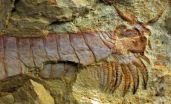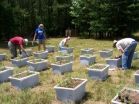(Press-News.org) STANFORD, Calif. — Hailed as a major step forward in the effort to develop targeted cancer therapies, a recently approved drug for the most common type of skin cancer has been a mixed blessing for patients. Although the initial response is usually dramatic, the tumors often recur as the cancer becomes resistant to treatment.
Now researchers at the Stanford University School of Medicine have identified a second way to block the activity of the signaling cascade, called the Hedgehog pathway, that is abnormally active in these cancers. The researchers hope the new approach may not only one day help patients with tumors that have become resistant to the first drug, vismodegib (marketed as Erivedge), but may also provide a novel combination therapy for newly diagnosed tumors that may be more effective than either treatment alone.
"These new, highly targeted therapies work really well," said dermatology professor Anthony Oro, MD, PhD, who was one of several Stanford researchers involved in the multiyear effort that brought vismodegib to market in 2012. "But this type of treatment is a race against evolution. Within a year, many of the tumors recur when the cancers become resistant to the inhibitor."
The effect on patients, particularly those with a severe condition called Gorlin syndrome, is a heartbreaking yo-yo as the tumors that cover most of their bodies disappear within weeks, but often recur in force.
But Oro and his colleagues' discovery of another, previously unknown component of the Hedgehog pathway — a component vital to its cancer-causing ability — could address this problem. Blocking the activity of this protein, called aPKC, can stop the growth in mice of transplanted skin tumors and tumor cells resistant to vismodegib. The finding, which will be published Feb. 28 in Nature, may pave the way to a future in which cancers are treated with more than one specifically targeted drug.
"Although these tumors evolve in response to targeted drug treatment, we believe there's a limited number of ways they can escape these therapies," said Oro. "If we were able to hit them at the time of diagnosis with drugs that target more than one step in the pathway, they may be less able to evade treatment. We've identified a new target in the Hedgehog pathway and we've developed an inhibitor of this target that we hope will work in human cancers."
Oro, who is the senior author of the study, was also one of several authors on a series of three papers in the New England Journal of Medicine last June describing the effectiveness of vismodegib in treating the most common type of skin cancer, basal cell carcinoma. Postdoctoral scholar Scott Atwood, PhD, is the lead author of the current study.
Taken together, the recent studies illustrate the nature of the constant battle among physicians and the rapidly growing and changing cancer cells they strive to eradicate. Targeted treatments that focus on unique vulnerabilities exhibited by specific types of cancers can be highly effective. They can also minimize the unpleasant side effects of less-specific treatments that kill many other non-cancerous cells. But their very specificity encourages and drives the tumor cells to evolve resistance in a way that might not be possible against a more broad-based therapeutic approach. Many researchers believe that a multipronged attack targeted at more than one point in critical cancer-causing pathways could be an effective way to combat resistance.
"Our goal is to provide precision cancer care at the time of diagnosis," said Atwood. "We're working toward developing better, more specific single and combination therapies to reduce the chance of resistance through tumor evolution."
The Hedgehog pathway is critical to many aspects of embryo development in animals as diverse as fruit flies and humans. When abnormally activated, it can cause uncontrolled cell growth. The pathway was first linked to human cancer about 16 years ago by researchers, including Stanford professor of developmental biology Matthew Scott, PhD. Since that time, researchers around the world, including a large group at Stanford, have worked to learn more about the pathway and how to inhibit it.
That work led to the development of vismodegib, which blocks a protein called Smoothened, or Smo, that acts near the beginning of the Hedgehog pathway. Smo sits in the cell membrane and sends signals into the interior of the cell. When activated, it initiates a biological cascade of signaling molecules that culminates in the cell's nucleus at a protein called Gli, which governs gene expression.
Oro and Atwood discovered another, previously unknown protein player in the Hedgehog pathway called aPKC. This protein perpetuates Gli's ability to transcribe, or activate, certain genes by giving it a specific molecular tag (a process called phosphorylation). The phosphorylated Gli in turn goads aPKC to higher levels of activity in what's known as a positive feedback loop.
The researchers studied human skin cancer cells removed from patients and grown in a laboratory dish. They also used a model in which basal cell carcinomas were transplanted onto mice. They looked at levels of aPKC activity and gene expression profiles in the tumors.
"We've found that aPKC is highly active in human basal cell carcinomas that have become resistant to vismodegib," said Atwood. "This positive feedback with aPKC allows tumors to grow really well even in the presence of vismodegib."
When the researchers used an aPKC inhibitor to treat mice bearing transplanted tumors or tumor cells resistant to Smo inhibitors, the growth of the cancer cells was suppressed and the tumors shrank.
The researchers are now working to optimize the selection and design of the aPKC inhibitor. They are also interested in exploring its effect in other cancers in which the Hedgehog pathway is implicated.
"There are a host of Hedgehog-dependent cancers," said Oro, "and we have many researchers and clinicians here at Stanford poised to conduct clinical trials of these types of therapies. It's very exciting."
###
Other Stanford researchers involved in the work include former undergraduate student Mischa Li, technician Alex Lee and assistant professor of dermatology Jean Tang, MD, PhD.
The research was funded by the National Institutes of Health (grants 1F32CA14208701, AR052785 and AR046786). Information about Stanford's Department of Dermatology, which also supported the work, is available at http://dermatology.stanford.edu/.
The Stanford University School of Medicine consistently ranks among the nation's top medical schools, integrating research, medical education, patient care and community service. For more news about the school, please visit http://mednews.stanford.edu. The medical school is part of Stanford Medicine, which includes Stanford Hospital & Clinics and Lucile Packard Children's Hospital. For information about all three, please visit http://stanfordmedicine.org/about/news.html.
Print media contact: Krista Conger at (650) 725-5371 (kristac@stanford.edu)
Broadcast media contact: M.A. Malone at (650) 723-6912 (mamalone@stanford.edu) END
Discovery opens door to multipronged attack against skin common cancer, Stanford study shows
2013-02-28
ELSE PRESS RELEASES FROM THIS DATE:
Feeding limbs and nervous system of one of Earth's earliest animals discovered
2013-02-28
An extraordinary find allowing scientists to see through the head of the 'fuxianhuiid' arthropod has revealed one of the earliest evolutionary examples of limbs used for feeding, along with the oldest nervous system to stretch beyond the head in fossil record.
Until now, all fossils found of this extremely early soft-bodied animal featured heads covered by a wide shell or 'carapace', obscuring underlying contents from detailed study.
But a new fossil-rich site in South China has been found to contain arthropod examples where the carapace has literally been 'flipped' over ...
What is the cost of rare diseases such as Friedreich's Ataxia?
2013-02-28
What is the cost of rare diseases such as Friedreich's Ataxia? By analyzing direct and indirect costs of care research in BioMed Central's open access journal Orphanet Journal of Rare Diseases calculated that conservatively this rare disease costs between £11,000 and £19,000 per person per year. Proper understanding resource allocation is important in minimizing the effect of Friedreich's Ataxia on people's lives while maximizing their quality of life.
Diseases are classified as 'rare' if they affect less than 1 in 2000 people. Lack of scientific knowledge means that ...
IV fluids used by NHS responsible for unnecessary deaths
2013-02-28
Starch-based intravenous (IV) fluids used by the NHS to treat seriously ill patients are causing unnecessary deaths, according to a new Cochrane systematic review by researchers at the London School of Hygiene & Tropical Medicine.
Based on data from 25 randomised control trials, the researchers concluded that starch-based colloid fluids, used to stabilise patients with low blood pressure, are not only more expensive than saline-based crystalloid fluids, but may also be causing around 250 unnecessary deaths in the UK every year.
The study included 9,147 seriously ill ...
Supermassive black hole spins super-fast
2013-02-28
Imagine a sphere more than 2 million miles across - eight times the distance from Earth to the Moon - spinning so fast that its surface is traveling at nearly the speed of light. Such an object exists: the supermassive black hole at the center of the spiral galaxy NGC 1365.
Astronomers measured its jaw-dropping spin rate using new data from the Nuclear Spectroscopic Telescope Array, or NuSTAR, and the European Space Agency's XMM-Newton X-ray satellites.
"This is the first time anyone has accurately measured the spin of a supermassive black hole," said lead author Guido ...
Silver nanoparticles may adversely affect environment
2013-02-28
DURHAM, N.C. -- In experiments mimicking a natural environment, Duke University researchers have demonstrated that the silver nanoparticles used in many consumer products can have an adverse effect on plants and microorganisms.
Fifty days after scientists applied a single low dose of silver nanoparticles, the experimental environments produced about a third less biomass in some plants and microbes.
These preliminary findings are important, the researchers said, because little is known about the environmental effects of silver nanoparticles, which are found in textiles, ...
Research explores factors that impact adolescent mental health
2013-02-28
Research indicates that half of all lifetime cases of mental illness begin by age 14, well before adulthood. Three new studies investigate the cognitive, genetic and environmental factors that may contribute to mental health disorders in adolescence. The studies are published in Psychological Science and Clinical Psychological Science, journals of the Association for Psychological Science.
Social-Information-Processing Patterns Mediate the Impact of Preventive Intervention on Adolescent Antisocial Behavior
Kenneth A. Dodge, Jennifer Godwin, and The Conduct Problems ...
NuSTAR helps solve riddle of black hole spin
2013-02-28
An international team including Lawrence Livermore National Laboratory scientists has definitively measured the spin rate of a supermassive black hole for the first time.
The findings, made by the two X-ray space observatories, NASA's Nuclear Spectroscopic Telescope Array (NuSTAR) and the European Space Agency's XMM-Newton, solve a long-standing debate about similar measurements in other black holes and will lead to a better understanding of how black holes and galaxies evolve.
"We can trace matter as it swirls into a black hole using X-rays emitted from regions very ...
First grade math skills set foundation for later math ability
2013-02-28
Children who failed to acquire a basic math skill in first grade scored far behind their peers by seventh grade on a test of the mathematical abilities needed to function in adult life, according to researchers supported by the National Institutes of Health.
The basic math skill, number system knowledge, is the ability to relate a quantity to the numerical symbol that represents it, and to manipulate quantities and make calculations. This skill is the basis for all other mathematics abilities, including those necessary for functioning as an adult member of society, a ...
A game plan for climate change
2013-02-28
Researchers have successfully piloted a process that enables natural resource managers to take action to conserve particular wildlife, plants and ecosystems as climate changes.
The Adaptation for Conservation Targets (ACT) framework is a practical approach to assessing how future changes in air and water temperatures, precipitation, stream flows, snowpack, and other environmental conditions might affect natural resources. ACT enables scientists and managers to work hand-in-hand to consider how management actions may need to be adjusted to address those impacts.
"As ...
Changing shape makes chemotherapy drugs better at targeting cancer cells
2013-02-28
(Santa Barbara, Calif. –) Bioengineering researchers at University of California, Santa Barbara have found that changing the shape of chemotherapy drug nanoparticles from spherical to rod-shaped made them up to 10,000 times more effective at specifically targeting and delivering anti-cancer drugs to breast cancer cells.
Their findings could have a game-changing impact on the effectiveness of anti-cancer therapies and reducing the side effects of chemotherapy, according to the researchers. Results of their study were published recently in Proceedings of the National Academy ...



